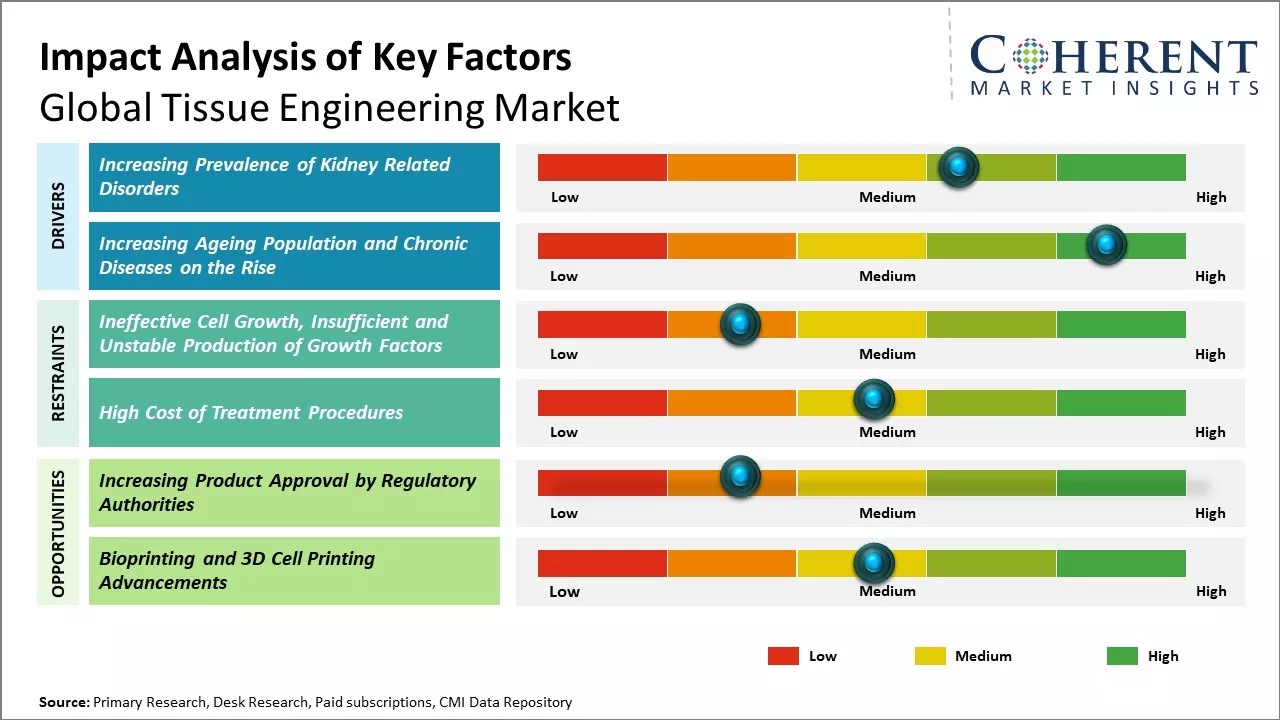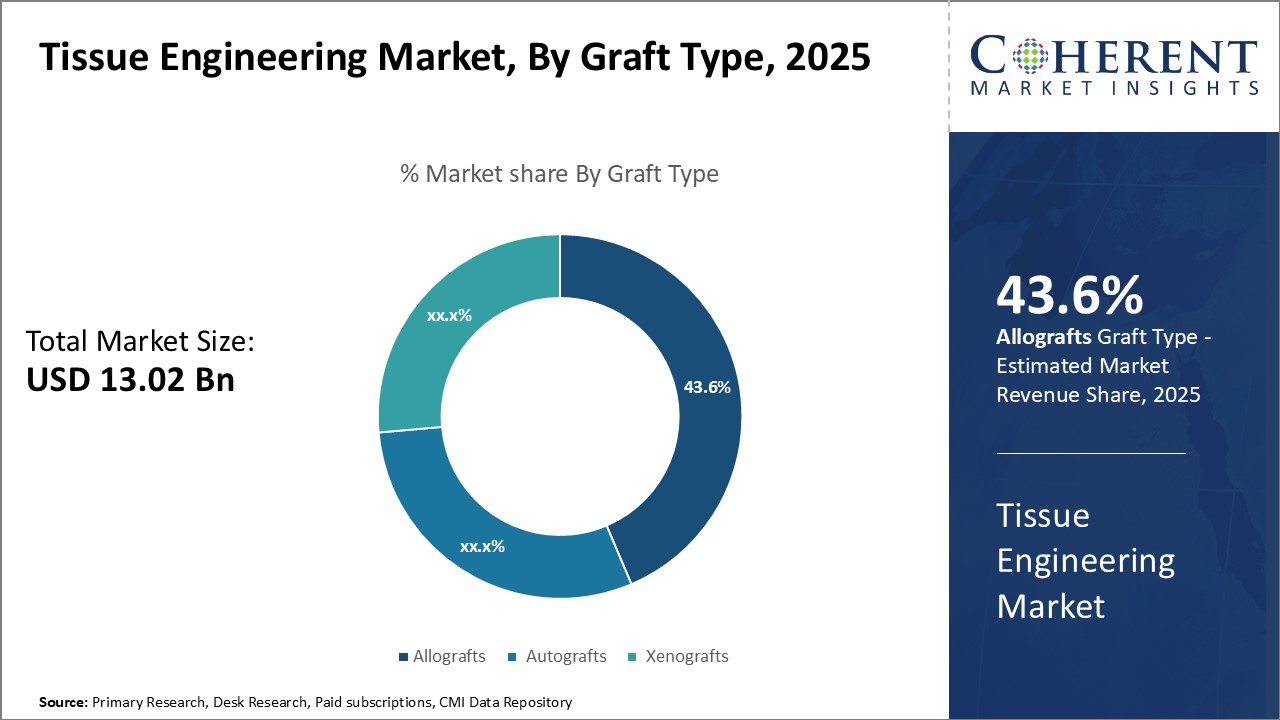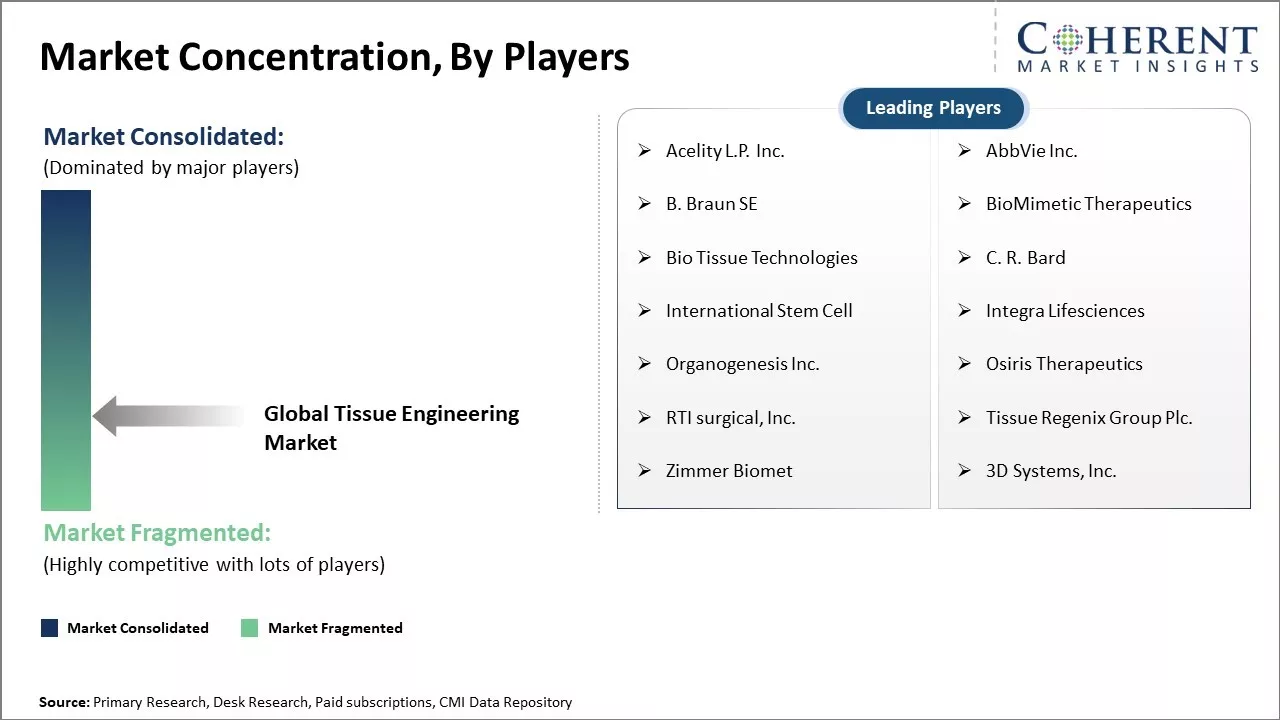
Tissue Engineering Market is estimated to be valued at USD 13.02 Bn in 2025 and is expected to reach USD 28.97 Bn in 2032, exhibiting a compound annual growth rate (CAGR) of 12.1% from 2025 to 2032.

To learn more about this report, Download Free Sample
The Tissue Engineering Market Size is expanding quickly due to a number of factors which includes a shift toward generative and customized care, rising rates of chronic diseases, and technological breakthroughs. The global tissue engineering market is also witnessing significant growth due to the ongoing research and development activities in regenerative medicine. The clinical translation of various tissue-engineered products and the commercialization of these products are expected to provide new opportunities for market growth over the coming years. Many companies are investing extensively in developing advanced tissue-engineered products for applications across various therapeutic areas.
|
Event |
Description and Impact |
|
Surge in Chronic Wounds and Aging Population in Europe |
|
|
Strategic Collaborations Between Hospitals and Biotech Firms |
|
Uncover macros and micros vetted on 75+ parameters: Get instant access to report
Artificial intelligence (AI) is significantly transforming the tissue engineering market by accelerating research, optimizing manufacturing processes, and enabling the development of personalized therapies. AI-driven algorithms are being used to analyze complex biological data, predict cell behavior, and design biocompatible scaffolds with greater precision.
The European Union is actively funding AI integration in biomedical research through initiatives like GenAI4EU, which supports projects aimed at advancing predictive and personalized medicine in tissue engineering. These efforts not only enhance the competitiveness of the European sector but also make healthcare treatments more effective by leveraging AI for improved diagnostics, patient stratification, and treatment planning.
The tissue engineering market is characterized by high costs due to the advanced nature of the technologies involved, including the use of specialized biomaterials, stem cells, and sophisticated manufacturing processes such as 3D bioprinting.
Pricing remains a challenge, with the high cost of development and production often passed on to end users, making widespread adoption more difficult, especially in cost-sensitive healthcare systems.
However, as the market matures and production scales up, there is potential for prices to moderate. The presence of robust research and development activities and increased funding in Europe may help drive down costs over time, but currently, the high price point remains a key restraint for broader market penetration.

To learn more about this report, Download Free Sample
The graft type segment includes, autografts, and xenografts. The allografts sub-segment is estimated to hold 43.6% of the market share in 2025 owing to their natural compatibility advantages. Allografts involve transplanting tissue from one individual to genetically non-identical individuals of the same species.
Compared to autografts which involve harvesting tissue from one site in the body and transplanting it to another site in the patient, allografts provide a more abundant source of graft material that does not require additional surgery or damage to healthy tissues in the patient’s own body.
Allografts are also more compatible options than xenografts which involve tissues from other species. While xenografts from sources like pigs offer more abundant availability, they carry greater immunological rejection risks as the tissues come from non-human donors. Allograft tissues on the other hand are derived from human donors and thus closely match the biological properties of the recipient’s tissues. This greater similarity minimizes immune responses and increases biocompatibility.
The material type segment includes synthetic, biological, and others. The synthetic sub-segment is estimated to hold 53.2% of the market share in 2025 owing to their ability to mimic native tissue attributes better than biological or other options. Tissue engineering applications demand scaffolding or matrices that can support cell growth and tissue generation over time.
Compared to biological matrices, synthetics allow for higher control over physical and mechanical characteristics through meticulous engineering approaches. Specifically, synthetic polymers can be designed with precise pore sizes, shapes and interconnectivity to maximize nutrient diffusion, waste removal and new tissue infiltration. Their mechanical properties like stiffness, strength and viscoelasticity can also be tuned to closely match those of target natural tissues.
This level of engineered biomimicry proves more difficult with bio-sourced materials. Moreover, synthetics demonstrate excellent flexibility for modification with cell-adhesive ligands, growth factors and other bioactive molecules to promote cell proliferation and differentiation.
The application segment includes dermal, orthopedic, dental, neurology, and others. The orthopedic sub-segment is estimated to hold 39.9% of the market share in 2025 due to sizeable clinical demands and limited alternative treatment options. Age-related degeneration and injuries are leading to rapidly rising incidences of musculoskeletal diseases worldwide. Traditional options like joint replacements have limitations in longevity, biocompatibility, and natural biomechanical functioning.
Tissue engineering presents an attractive regenerative approach but orthopedic reconstruction poses bigger material challenges than other areas due to the structural rigor required. Scaffolds and matrices aimed at bone, cartilage, and tendon repair must replicate the complex compositional heterogeneities and mechanical properties of load-bearing connective tissues.
Significant research progress is being made to develop osteochondral grafts, injectable hydrogels, nanofibrous meshes and three-dimensional printed biomaterials that can facilitate cellular recellularization and tissue regeneration for orthopedic injuries like spinal fusion, osteoarthritis, fracture non-unions and ligament tears. Additionally, cell-based therapies utilizing mesenchymal stem cells, platelets and growth factors are demonstrating potential in cartilage and osteochondral repair.

To learn more about this report, Download Free Sample
North America remains the dominant region in the global tissue engineering market and is estimated to hold 37.9% of the market share in 2025. Strong industry presence of leading tissue engineering companies such as Organogenesis and Smith & Nephew has established the region as the innovation hub. These companies have invested heavily in R&D to develop advanced tissue engineering products and technologies.
In addition, favorable government policies supporting regenerative medicine research through increased funding have boosted tissue engineering activities. The presence of advanced healthcare infrastructure and high healthcare spending have also created a conducive environment for new tissue engineering therapies.
A large patient pool suffering from chronic wounds, musculoskeletal disorders, and other degenerative diseases demand innovative treatment options, are driving the adoption of tissue engineering products. Other factors such as wide medical insurance coverage and availability of skilled workforce have further aided the regional market growth.
Asia Pacific market is witnessing fastest expansion and is expected to grow at a high rate during the forecast period. Rising healthcare expenditure, increasing healthcare access, and growing incidences of target diseases are some major macroeconomic factors driving the Asia Pacific tissue engineering industry.
Countries like China, India, and South Korea are emerging as lucrative markets with the presence of strong bioscience industries and constantly improving medical infrastructure. China and India also have large talent pool of skilled researchers supporting domestic tissue engineering research.
Additionally, governments of various APAC countries are promoting regenerative medicine through funding initiatives to develop indigenous product development capabilities. This has attracted global tissue engineering companies to establish manufacturing and R&D bases in the region. With increasing regional exports, Asia Pacific is gradually stepping up as a global production hub for tissue engineering products.
Orthopedics, musculoskeletal, and spine applications currently represent the largest segment, while cardiology and vascular applications are the fastest-growing, indicating broadening clinical adoption. Innovative technologies such as 3D bioprinting, stem cell therapies, and scaffold-based techniques are enhancing the precision and scalability of engineered tissues, making them increasingly viable for use in wound healing, bone regeneration, organ replacement, and cosmetic reconstruction.
The U.S. market is characterized by a strong presence of leading biotechnology companies, robust university research programs, and favorable regulatory support from agencies like the FDA and NIH. Orthopedics, musculoskeletal, and spine applications hold the largest market share, while cardiology and vascular applications are witnessing the fastest growth.
The country is witnessing a rise in R&D activities, particularly in academic and research institutions, which are collaborating with biotechnology firms to develop cost-effective and scalable tissue engineering solutions. While the market size lags behind that of the U.S. and China, India’s large population, rising healthcare expenditure, and government initiatives to promote biomedical research are expected to accelerate growth in the coming years.
China’s large patient population and rising incidence of chronic diseases create a substantial demand for tissue engineering solutions, particularly in orthopedics, wound healing, and organ regeneration. The government’s focus on innovation, combined with increasing collaborations between academic institutions and industry, has enabled China to accelerate product development and commercialization.
| Report Coverage | Details | ||
|---|---|---|---|
| Base Year: | 2024 | Market Size in 2025: | USD 13.02 Bn |
| Historical Data for: | 2020 To 2024 | Forecast Period: | 2025 To 2032 |
| Forecast Period 2025 to 2032 CAGR: | 12.1% | 2032 Value Projection: | USD 28.97 Bn |
| Geographies covered: |
|
||
| Segments covered: |
|
||
| Companies covered: |
Acelity L.P. Inc., AbbVie Inc., B. Braun SE, BioMimetic Therapeutics, Bio Tissue Technologies, C. R. Bard, International Stem Cell, Integra Lifesciences, Organogenesis Inc., Osiris Therapeutics, RTI surgical, Inc., Tissue Regenix Group Plc., Zimmer Biomet, and 3D Systems, Inc. |
||
| Growth Drivers: |
|
||
| Restraints & Challenges: |
|
||
Uncover macros and micros vetted on 75+ parameters: Get instant access to report

To learn more about this report, Download Free Sample
Tissue engineering is gaining traction in various areas such as wound care, burn treatment, orthopedics, neurology, urological products, and others. Tissue engineering can play an important role in the management of pediatric patients. Tissue or organs absent at the time of birth, in congenital anomalies such as bladder exstrophy, oesophageal atresia, and congenital diaphragmatic hernia pose a serious challenge in surgical repair.
Moreover, tissue engineering approaches have become a significant area of interest in burn wound management. Tissue engineered skin substitutes have great potential for widespread applications in wound healing, particularly to address the limited availability of autologous skin increasing burn and trauma related injuries are expected to drive the global tissue engineering market growth.
For instance, in February 2022, according to the American Chemical Society, the prevalence of chronic kidney disease (CKD) in the general population is estimated to be as high as 14% across the globe.
With an ageing population and chronic diseases on the rise, there is a need for more effective medical treatments and therefore a need for trained tissue engineering researchers to deliver these technologies. Tissue engineering offers alternatives to surgical reconstruction, transplantation, and directing mechanical devices to repair damaged tissues.
For instance, in March 2020, according to the National Library of Medicine, spinal cord injury (SCI) affects an estimated three million persons worldwide, with ∼180,000 new cases reported each year leading to severe motor and sensory functional impairments that affect personal and social behaviors. As tissue engineering technology is being developed for use in a variety of different fields, particularly in the biomedical field, a clear understanding of the mechanisms of tissue engineering is important.
Adoption is further accelerated by the noticeable shift toward personalized care and the customization of tissue engineering treatments to meet the demands of specific patients. Applications are becoming more varied; the highest market share is held by orthopedics and musculoskeletal treatments, while the quickest increase is seen in cardiology and vascular applications.
Due to growing bioscience sectors, supportive government initiatives, and rising healthcare costs, the Asia-Pacific region—especially China and India—is becoming a key growth hub. North America, however, continues to be the prominent region due to significant R&D expenditure, sophisticated healthcare infrastructure, and the presence of major market competitors.
For instance, in June 2023, the Sree Chitra Tirunal Institute for Medical Sciences and Technology (SCTIMST), named Cholederm, received an approval from the Central Drugs Standard Control Organisation (CDSCO) as a Class D medical device. Cholederm is a wound healing material derived from the extracellular matrix of de-cellularised gall bladder of pig and tissue engineered as membrane forms of scaffold, by the researchers at the Division of Experimental Pathology in the Biomedical Technology wing of SCTIMST.
Some of the key players in the global Tissue Engineering market are Acelity L.P. Inc., AbbVie Inc., B. Braun SE, BioMimetic Therapeutics, Bio Tissue Technologies, C. R. Bard, International Stem Cell, Integra Lifesciences, Organogenesis Inc., Osiris Therapeutics, RTI surgical, Inc., Tissue Regenix Group Plc., Zimmer Biomet, and 3D Systems, Inc.
*Definition: Tissue engineering is an interdisciplinary field addressed to develop functional three-dimensional tissues combining cells, scaffolds, and bioactive molecules. This field involves scientific areas such as cell biology, chemistry, material science, molecular biology, medicine, and engineering. It can be used to develop functional constructs that can be used to reestablish, maintain or improve the condition of injured body parts or tissues. Tissue engineering also assist in regeneration of damaged tissues by combining cells from the body with highly porous scaffold biomaterials. Scaffold biomaterials act as templates for tissue regeneration and guide the growth of new tissue.
Share
Share
About Author
Abhijeet Kale is a results-driven management consultant with five years of specialized experience in the biotech and clinical diagnostics sectors. With a strong background in scientific research and business strategy, Abhijeet helps organizations identify potential revenue pockets, and in turn helping clients with market entry strategies. He assists clients in developing robust strategies for navigating FDA and EMA requirements.
Missing comfort of reading report in your local language? Find your preferred language :
Transform your Strategy with Exclusive Trending Reports :
Frequently Asked Questions
Joining thousands of companies around the world committed to making the Excellent Business Solutions.
View All Our Clients